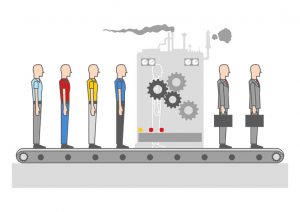 An area of knowledge is, according to PMBOK (Project Management Body of Knowledge), "an identified area of project management defined by its knowledge requirements and described in terms of its processes, practices, initial data, results, tools and techniques that compose them. " In fact, all project management processes contained in the PMBOK are divided into 10 areas.
An area of knowledge is, according to PMBOK (Project Management Body of Knowledge), "an identified area of project management defined by its knowledge requirements and described in terms of its processes, practices, initial data, results, tools and techniques that compose them. " In fact, all project management processes contained in the PMBOK are divided into 10 areas.
In addition to the famous 6 phases of project management, the PMBOK contains 10 areas of knowledge:
-
Project integration
-
Project scope management
-
Project time management
-
Project cost management
-
Project quality management
-
Project Human Resource Management
-
Project Communication Management
-
Project Risk Management
-
Project Procurement Management
-
Project Stakeholder Management
In this article, we review the first area of knowledge: Project integration.
The management of PMBOK project integration brings together the processes and activities necessary for the project to exist beyond its parts. Without integration, the project is nothing more than a value proposition with a goal; Once the components are identified and defined to integrate them around the scope to be produced, the project is sufficiently defined to be accepted.
Integration, however, should not be confused with initiation: in fact, it is a beginner's mistake to integrate the components only when defining the project: integration must be maintained throughout the project life cycle, along with the six management processes in this area of knowledge.
The 4 keys to improvement in this area of knowledge are:
-
Gain acceptance
-
Create an attack plan
-
Be willing to make concessions and rectifications
- Learn from mistakes and successes in project closure
Obtain acceptance
Integration management will be effective if we gain the support of all team members and, above all, stakeholders. Getting acceptance from the start of the project ensures that we have the support and funding to succeed. To do this, we start by creating a Project Plan and a Preliminary Reach Statement.
The Project Plan marks the beginning of the project and includes the necessary approvals and corrections. In addition, it authorizes the project manager to direct and organize the resources, which will be reflected in this letter, being well defined in their roles and responsibilities.
In the Preliminary Scope Statement we indicate the scope of the project, we define the reasons for undertaking this initiative, the objectives, the possible limitations, the possible solutions and identify the important stakeholders affected by this project. This document defines the project itself, as well as the strategy that must be followed for the change control process.
With these two documents we will be able to guarantee that the resources are coordinated and programmed in the form and time that are needed.
Create an attack plan
We begin by identifying the activities that will be necessary to effectively execute, manage and monitor the project. It will be necessary to have a project management software that allows for planning and supervision of the project at any time and from anywhere.
With a Gantt, we can visualize the project tasks and the assigned resources. In addition, we will get daily status updates, necessary to effectively manage the project.
As the project progresses, so that reporting and monitoring among all team members is more accurate and timely, we should emphasize that everyone updates the completion status of their tasks. Otherwise, its use is very easy and intuitive.
Be willing to make concessions
One of the biggest challenges that we will face in implementing the project is the management of people. The interests and opinions may be overlapping between managers of different departments and on multiple occasions they may ask to make changes in the planning of our project.
For us to be effective we must be willing to make concessions, although we may not always be able to give them what they ask of us. Above all is the project, which must meet the objectives and requirements set out in the Project Plan.
We must ensure that the team is doing its part of the project correctly and make sure that the work is completed according to the requirements in the Preliminary Reach Statement. We must monitor and control project work by measuring and balancing project progress; and carrying out corrective or preventative actions, to ensure compliance with all objectives.
It is important that we follow the established process for change control as defined in the Preliminary Reach Statement, and when a change request is made, make sure it goes through the appropriate channels before it becomes part of the plan.
Each change request must be evaluated individually and we would only implement validated and approved changes that will help us to achieve the project objectives.
Learning from mistakes and also successes
At the beginning of the project we clearly defined all the activities, and at the end of the project all we have to do is verify that the activities are all completed and that the final product or service meets the expectations of the client and the interested parties. It is desirable that we obtain written approval of the completion of the project.
Once the project is finished, it is about learning from any mistakes and successes. We organize a formal meeting with the team members and have a brainstorming session, listing one by one all the errors observed during the project. We also make a list of things that went well.
The weaknesses that we have encountered, the threats of the environment suffered, the strengths that we have detected as a team and the opportunities that we have known or did not take advantage of, everything learned in this experience, will serve us for the next project in which we will be more effective.



 When evaluating different tools, soft virtues such as the ability to adapt to different situations are often overlooked.
When evaluating different tools, soft virtues such as the ability to adapt to different situations are often overlooked. Man-hours, also called person-hours, are the unit of measure that is used in project management to measure the efforts needed to complete a task.
Man-hours, also called person-hours, are the unit of measure that is used in project management to measure the efforts needed to complete a task.
 Making organizational changes in any process, work methodology or project management system is, in itself, a very difficult project to manage. When it comes to internal management, the cost of a failed project is very high, so the margin of error is small. To make matters worse, the response of the people involved in the process makes it difficult to predict and difficult to design change plans that are followed closely.
Making organizational changes in any process, work methodology or project management system is, in itself, a very difficult project to manage. When it comes to internal management, the cost of a failed project is very high, so the margin of error is small. To make matters worse, the response of the people involved in the process makes it difficult to predict and difficult to design change plans that are followed closely. One of the greatest challenges of a PMO is to ensure that the experiences generated within a project are extended to the rest of the organization and not lost when the project team dissolves. Even within each project, reaching a knowledge baseline explicitly shared by all key team members can be tricky.
One of the greatest challenges of a PMO is to ensure that the experiences generated within a project are extended to the rest of the organization and not lost when the project team dissolves. Even within each project, reaching a knowledge baseline explicitly shared by all key team members can be tricky.